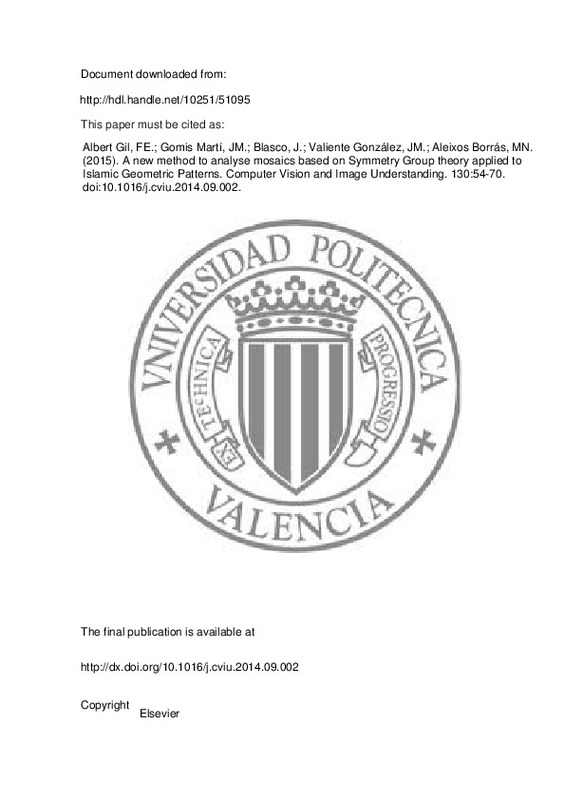JavaScript is disabled for your browser. Some features of this site may not work without it.
Buscar en RiuNet
Listar
Mi cuenta
Estadísticas
Ayuda RiuNet
Admin. UPV
A new method to analyse mosaics based on Symmetry Group theory applied to Islamic Geometric Patterns
Mostrar el registro sencillo del ítem
Ficheros en el ítem
| dc.contributor.author | Albert Gil, Francisco Eugenio
|
es_ES |
| dc.contributor.author | Gomis Martí, José María
|
es_ES |
| dc.contributor.author | Blasco, J.
|
es_ES |
| dc.contributor.author | Valiente González, José Miguel
|
es_ES |
| dc.contributor.author | Aleixos Borrás, María Nuria
|
es_ES |
| dc.date.accessioned | 2015-06-02T07:19:37Z | |
| dc.date.available | 2015-06-02T07:19:37Z | |
| dc.date.issued | 2015-01 | |
| dc.identifier.issn | 1077-3142 | |
| dc.identifier.uri | http://hdl.handle.net/10251/51095 | |
| dc.description.abstract | [EN] This article presents a new method for analysing mosaics based on the mathematical principles of Symmetry Groups. This method has been developed to get the understanding present in patterns by extracting the objects that form them, their lattice, and the Wallpaper Group. The main novelty of this method resides in the creation of a higher level of knowledge based on objects, which makes it possible to classify the objects, to extract their main features (Point Group, principal axes, etc.), and the relationships between them. In order to validate the method, several tests were carried out on a set of Islamic Geometric Patterns from different sources, for which the Wallpaper Group has been successfully obtained in 85% of the cases. This method can be applied to any kind of pattern that presents a Wallpaper Group. Possible applications of this computational method include pattern classification, cataloguing of ceramic coatings, creating databases of decorative patterns, creating pattern designs, pattern comparison between different cultures, tile cataloguing, and so on. | es_ES |
| dc.description.sponsorship | The authors wish to thank the Patronato de la Alhambra y Generalife (Granada, Spain) and the Patronato del Real Alcázar de Sevilla (Seville, Spain) for their valuable collaboration in this research work. | |
| dc.language | Inglés | es_ES |
| dc.publisher | Elsevier | es_ES |
| dc.relation.ispartof | Computer Vision and Image Understanding | es_ES |
| dc.rights | Reserva de todos los derechos | es_ES |
| dc.subject | Mosaics | es_ES |
| dc.subject | Symmetry Groups | es_ES |
| dc.subject | Wallpaper Groups | es_ES |
| dc.subject | Point Groups | es_ES |
| dc.subject | Image understanding | es_ES |
| dc.subject | Tiles | es_ES |
| dc.subject | Islamic Geometric Patterns | es_ES |
| dc.subject | Pattern classification | es_ES |
| dc.subject.classification | EXPRESION GRAFICA EN LA INGENIERIA | es_ES |
| dc.title | A new method to analyse mosaics based on Symmetry Group theory applied to Islamic Geometric Patterns | es_ES |
| dc.type | Artículo | es_ES |
| dc.identifier.doi | 10.1016/j.cviu.2014.09.002 | |
| dc.rights.accessRights | Abierto | es_ES |
| dc.contributor.affiliation | Universitat Politècnica de València. Departamento de Informática de Sistemas y Computadores - Departament d'Informàtica de Sistemes i Computadors | es_ES |
| dc.contributor.affiliation | Universitat Politècnica de València. Instituto Interuniversitario de Investigación en Bioingeniería y Tecnología Orientada al Ser Humano - Institut Interuniversitari d'Investigació en Bioenginyeria i Tecnologia Orientada a l'Ésser Humà | es_ES |
| dc.contributor.affiliation | Universitat Politècnica de València. Departamento de Ingeniería Gráfica - Departament d'Enginyeria Gràfica | es_ES |
| dc.description.bibliographicCitation | Albert Gil, FE.; Gomis Martí, JM.; Blasco, J.; Valiente González, JM.; Aleixos Borrás, MN. (2015). A new method to analyse mosaics based on Symmetry Group theory applied to Islamic Geometric Patterns. Computer Vision and Image Understanding. 130:54-70. doi:10.1016/j.cviu.2014.09.002 | es_ES |
| dc.description.accrualMethod | S | es_ES |
| dc.relation.publisherversion | http://dx.doi.org/10.1016/j.cviu.2014.09.002 | es_ES |
| dc.description.upvformatpinicio | 54 | es_ES |
| dc.description.upvformatpfin | 70 | es_ES |
| dc.type.version | info:eu-repo/semantics/publishedVersion | es_ES |
| dc.description.volume | 130 | es_ES |
| dc.relation.senia | 269404 |







![[Cerrado]](/themes/UPV/images/candado.png)

